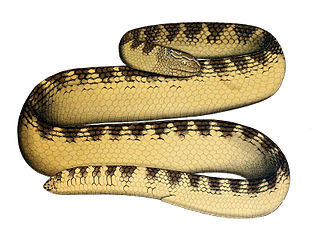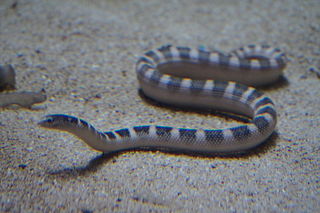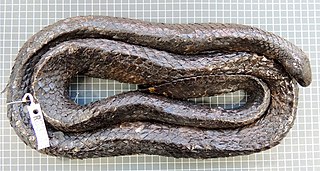
Aipysurus eydouxii, commonly known as the beaded sea snake, the marbled seasnake, and the spine-tailed seasnake, is a species of venomous snake in the family Elapidae. A. eydouxii is unusual amongst sea snakes in that it feeds almost exclusively on fish eggs. As part of this unusual diet, this species has lost its fangs, and the venom glands are almost entirely atrophied.

Stokes's sea snake is a large species of sea snake in the family Elapidae. It is sometimes placed in its own genus Astrotia. The species is endemic to tropical Indo-Pacific oceanic waters.

Hydrophis schistosus, commonly known as the beaked sea snake, hook-nosed sea snake, common sea snake, or the Valakadeyan sea snake, is a highly venomous species of sea snake common throughout the tropical Indo-Pacific. This species is implicated in more than 50% of all bites caused by sea snakes, as well as the majority of envenomings and fatalities.

Hydrophis ornatus, commonly known as the ornate reef sea snake, is a species of venomous sea snake in the family Elapidae.

Sea snakes, or coral reef snakes, are elapid snakes that inhabit marine environments for most or all of their lives. They belong to two subfamilies, Hydrophiinae and Laticaudinae. Hydrophiinae also includes Australasian terrestrial snakes, whereas Laticaudinae only includes the sea kraits (Laticauda), of which three species are found exclusively in freshwater. If these three freshwater species are excluded, there are 69 species of sea snakes divided between seven genera.

Hydrophis is a genus of sea snakes, venomous snakes in the subfamily Hydrophiinae of the family Elapidae. Species in the genus Hydrophis are typically found in Indo-Australian and Southeast Asian waters. Currently, around 36 species are recognized as being valid.

The wildlife of Liberia consists of the flora and fauna of the Republic of Liberia. This West African nation has a long Atlantic coastline and a range of habitat types, with a corresponding diversity of plants and animals. Liberia is considered a biodiversity hotspot and has more intact forests characteristic of the Upper Guinea Massif than do neighbouring countries. There are 2000 species of vascular plants, approximately 140 species of mammals, and over 600 species of birds.

The wildlife of Pakistan comprises a diverse flora and fauna in a wide range of habitats from sea level to high elevation areas in the mountains, including 195 mammal, 668 bird species and more than 5000 species of Invertebrates. This diverse composition of the country's fauna is associated with its location in the transitional zone between two major zoogeographical regions, the Palearctic, and the Oriental. The northern regions of Pakistan, which include Khyber Pakhtunkhwa and Gilgit Baltistan include portions of two biodiversity hotspot, Mountains of Central Asia and Himalayas.

Hydrophis peronii, commonly known as the horned sea snake, Peron's sea snake, and the spiny-headed seasnake, is a species of venomous snake in the subfamily Hydrophiinae of the family Elapidae. The species is endemic to the western tropical Pacific Ocean. It is the only sea snake with spines on the head. It is sometimes placed in its own genus Acalyptophis.

Australia has approximately 11,500 km2 of mangroves, primarily on the northern and eastern coasts of the continent. Areas where mangroves occur include the intertidal zone of tropical, subtropical and protected temperate coastal rivers, estuaries, bays and marine shorelines. Less than 1% of Australia's total forest area is mangrove forest.

The yellow-bellied sea snake is a venomous species of snake from the subfamily Hydrophiinae found in tropical oceanic waters around the world except for the Atlantic Ocean. For many years, it was placed in the monotypic genus Pelamis, but recent molecular evidence indicates it lies within the genus Hydrophis.

Aipysurus apraefrontalis, commonly known as the short-nosed sea snake or Sahul reef snake, is a critically endangered species of venomous sea snake in the family Elapidae, which occurs on reefs off the northern coast of Western Australia. English herpetologist Malcolm Arthur Smith described the species in 1926 from a specimen collected on the Ashmore Reef.
Hydrelaps is a monotypic genus of venomous sea snake in the family Elapidae. The genus contains the sole species Hydrelaps darwiniensis, also commonly known as the black-ringed mangrove snake, the black-ringed sea snake, Darwin's sea snake, and the Port Darwin sea snake. The species is native to Australia and New Guinea.
The northern mangrove seasnake, also known commonly as the Arafura smooth seasnake, is a species of venomous snake in the family Elapidae. The species is endemic to Australia and New Guinea.

The slender-necked sea snake, also known commonly as Cogger's sea snake, is a species of marine venomous snake in the subfamily Hydrophiinae of the family Elapidae. The species is native to waters around western Australia and the southern Pacific Ocean.

Hydrophis czeblukovi, also known commonly as the fine-spined sea snake, the geometrical sea snake, and the geometrical seasnake, is species of venomous snake in the subfamily Hydrophiinae of the family Elapidae. The species is native to waters off northern Australia.
The estuarine sea snake, also known commonly as Kharin's sea snake, is a species of marine venomous snake in the family Elapidae. The species is native to waters around the northern tip of Australia in the Torres Strait.
Cryptoblepharus pannosus, also known commonly as the ragged snake-eyed skink, is a species of lizard in the family Scincidae. The species is endemic to Australia.
Cryptoblepharus richardsi is a species of lizard in the family Scincidae. The species is endemic to Misima Island in the northwest of Louisiade Archipelago, Papua New Guinea.
Anilios ganei, also known commonly as Gane's blind snake, is a species of snake in the family Typhlopidae. The species is endemic to Australia.













